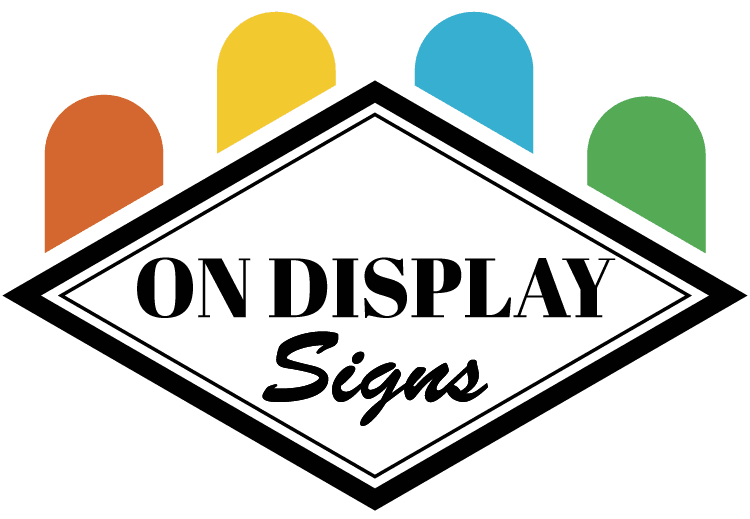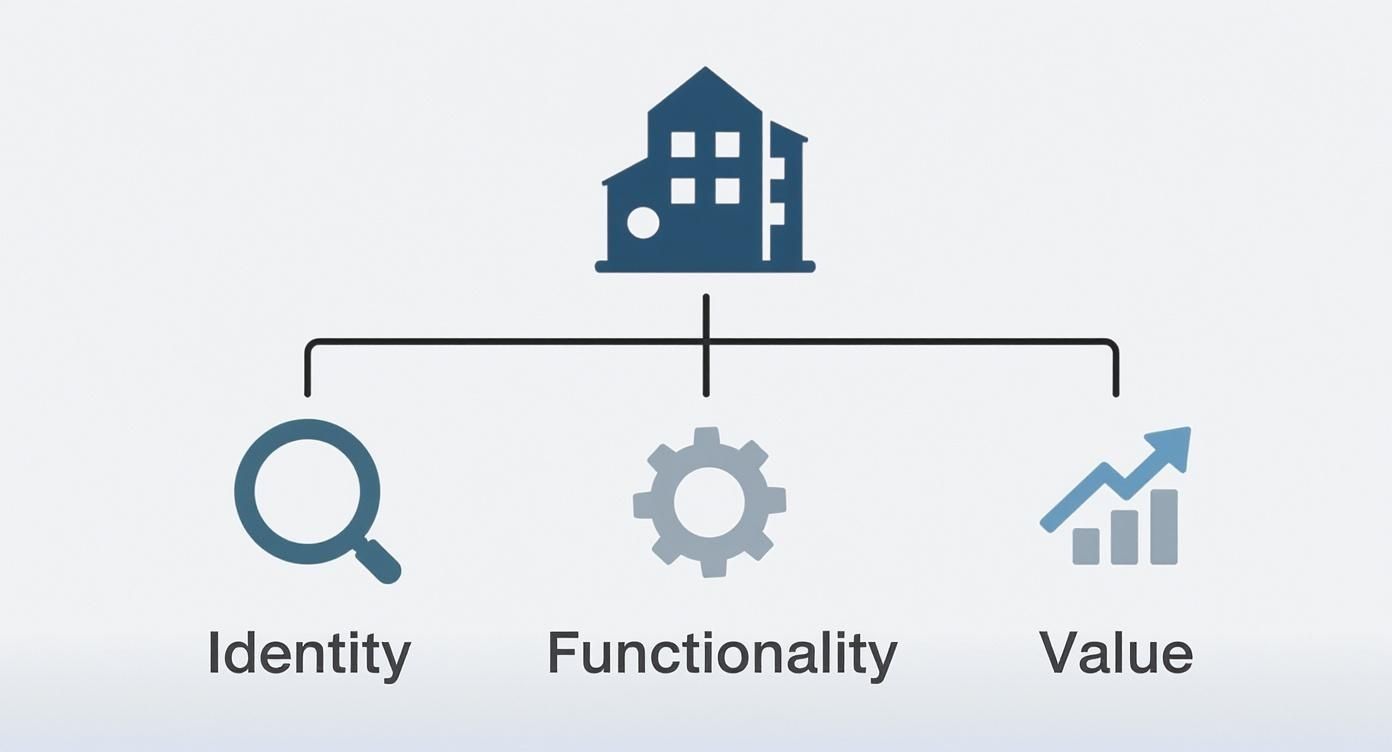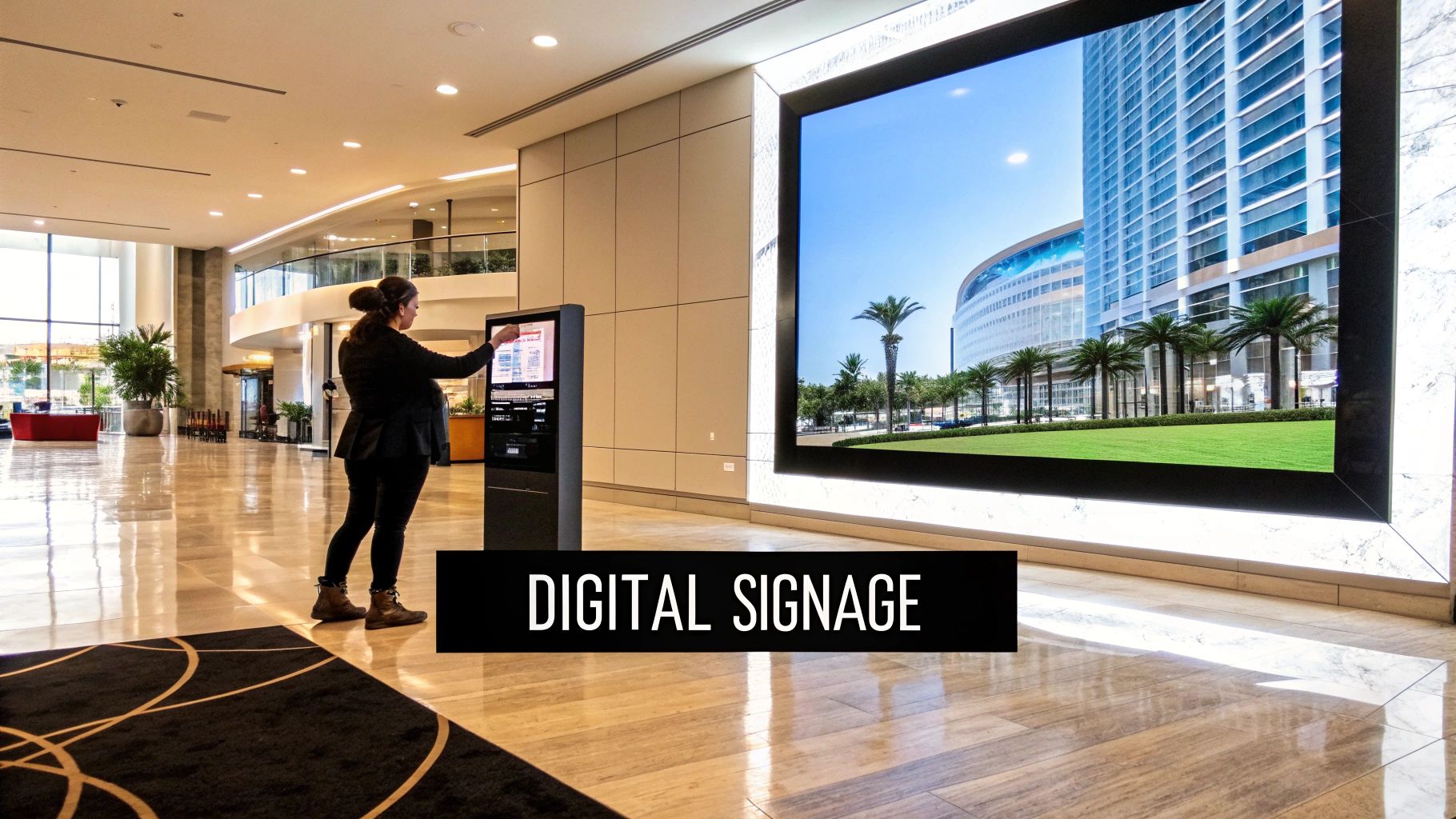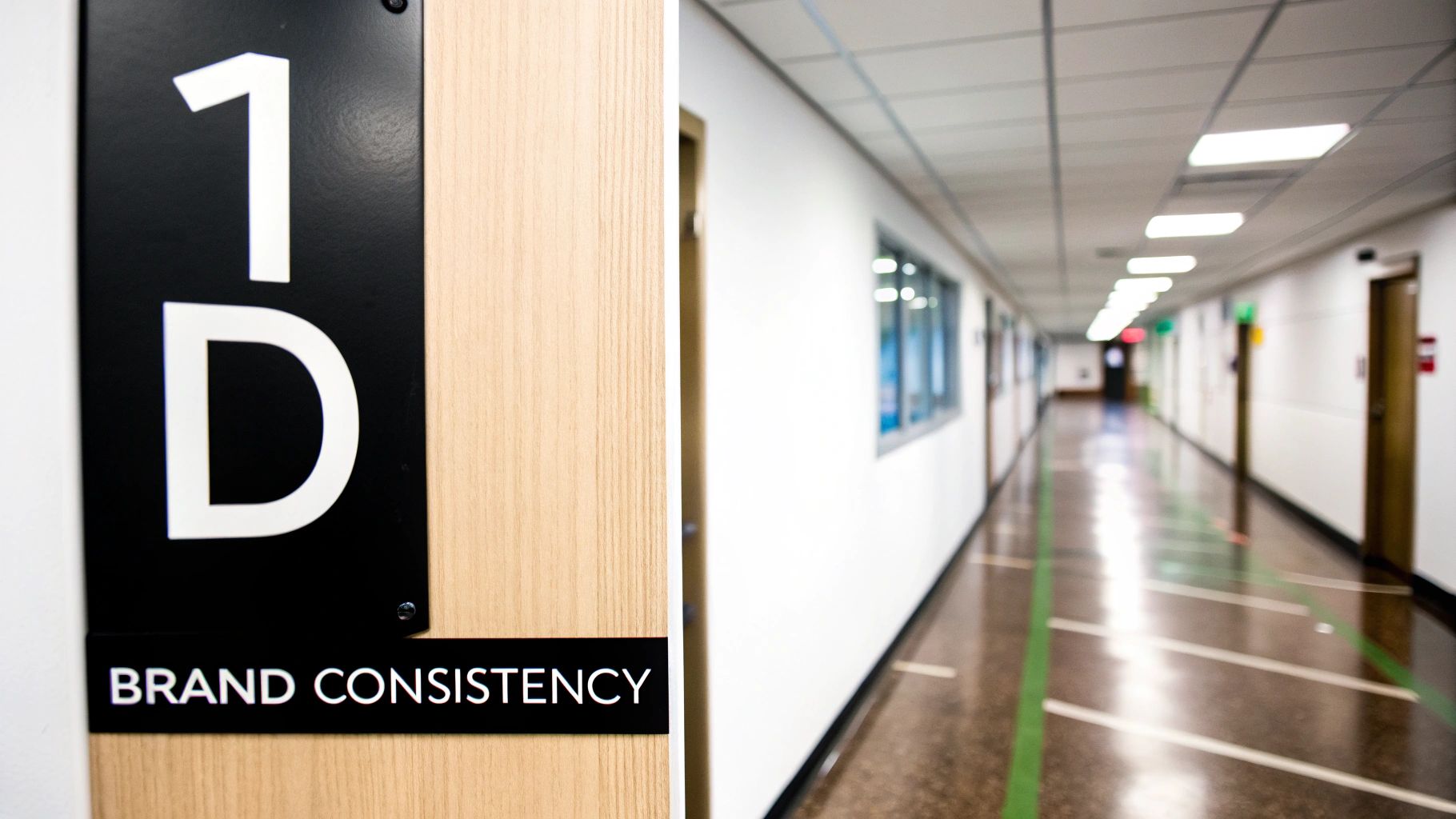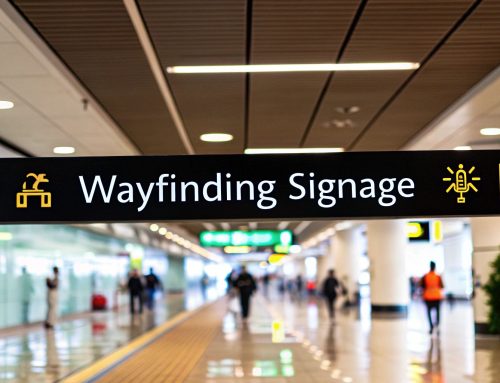Your building’s sign is so much more than a name on a wall—it's the first handshake you offer to the public. It’s the very first impression that sets the tone for every single visitor, tenant, and passerby. A great sign is a hardworking asset, communicating your identity and guiding people 24/7.
The Strategic Role of Commercial Building Signage
Stop thinking of your signage as just another expense. It's a critical investment in your property's identity, its day-to-day function, and its long-term success. The right signage strategy turns a confusing property into a welcoming one, gives a brand a real presence, and can seriously drive up the value of the building.
From the big outdoor signs that demand attention from the street to the interior wayfinding systems that get people where they need to go, a complete signage ecosystem is non-negotiable. For example, a medical complex with clear, consistent signage reassures patients from the moment they arrive, while an office park with a confusing layout can frustrate visitors before they even park.
This isn't just a trend; the numbers back it up. The global signage market is expected to rocket from USD 52.7 billion in 2025 to USD 97.3 billion by 2035—that's a staggering 84.6% jump. This massive growth is being driven by constant urbanization and the need for better communication everywhere from retail and healthcare to corporate campuses.
More Than Just a Landmark
A well-thought-out signage plan does a lot more than just put your name on the map. It serves several strategic jobs that directly impact your bottom line and how people feel about your space.
A smart system delivers:
- A Stronger Brand Identity: Your signs are a constant, physical reminder of your brand’s quality and professionalism. A law firm's classic brass plaque conveys tradition and stability, while a tech company's backlit logo suggests innovation.
- Effortless Navigation: Clear directions and wayfinding signs cut down on frustration, making for a smooth and positive experience from the second someone arrives. This reduces missed appointments and creates a more efficient flow of people.
- Higher Perceived Value: Professional, high-end signs signal that a property is well-maintained and premium, which helps attract better tenants and customers.
Signage is the silent salesperson for your building. It communicates your brand promise before a visitor even steps through the door.
For more inspiration on how to make a statement, you can check out our guide on business sign ideas. If you're looking to explore a wider range of visual communication tools, including diverse signs and banners, there are plenty of expert resources available. At the end of the day, investing in strategic signage is really an investment in your property's future.
Understanding the Core Types of Commercial Signage
Picking the right sign for a commercial building is all about understanding the specific job you need it to do. Think of different signs as specialized tools in a toolbox—each one is built for a particular purpose, whether it's shouting your brand from a distance or quietly guiding a visitor down a hallway.
Exterior signs are your property's first handshake. They’re the first physical touchpoint a person has with your building, working 24/7 to identify your location, direct traffic, and make an impression. These are the real workhorses of your entire signage strategy.
Interior signs, on the other hand, take over once someone steps inside. They’re all about managing the visitor experience by creating a sense of order, reinforcing who you are as a brand, and making the space easy to navigate. Good interior signage gets rid of confusion and makes the whole building feel more professional.
Essential Exterior Signage
Your outdoor signs have to be tough, clear, and impossible to ignore. Their main job is to make your building easy to spot and even easier to find.
-
Monument Signs: These are the low-profile, ground-level signs you see at the entrance to a property, often built from stone, brick, or concrete to match the building's vibe. A law firm might use a classic brick monument sign to project stability and permanence. They create an established, landmark feel right at the front door.
-
Pylon Signs: As the giants of the sign world, these tall, freestanding structures are all about maximum visibility from far away. They're perfect for businesses set back from the road or for shopping centers that need to list multiple tenants. A good pylon sign grabs the attention of passing traffic long before they reach the entrance. For instance, a hotel near a highway exit relies on a tall pylon sign to be seen by drivers and guide them in.
-
Channel Letters: These are the three-dimensional, individually crafted letters you often see mounted on a building's storefront. For a retail shop in a busy plaza, illuminated channel letters make the brand name pop, day or night. It’s what helps you stand out from all the visual noise from your neighbors.
This infographic breaks down how different signage elements come together to shape a property's identity, improve its function, and boost its overall value.
As you can see, a smart strategy finds the right balance between these pillars to build a signage system that just works.
To help clarify the roles these different signs play, here’s a quick breakdown of where they are typically used and what their main job is.
Commercial Signage Types and Their Primary Functions
| Sign Type | Primary Location | Key Function |
|---|---|---|
| Monument Sign | At property entrances, near the road | Establishes a permanent, high-end first impression. |
| Pylon Sign | Along highways or busy roadsides | Grabs attention from a long distance; lists multiple tenants. |
| Channel Letters | On the building facade or storefront | Provides bold, 24/7 brand identification. |
| Lobby/Reception Sign | Main entrance or waiting area | Reinforces brand identity and professionalism upon entry. |
| Wayfinding Signage | Hallways, elevators, intersections | Guides visitors and reduces confusion in large spaces. |
| ADA-Compliant Sign | Restrooms, exits, room identification | Ensures accessibility for all visitors and meets legal standards. |
Each type serves a distinct strategic purpose, working together to create a seamless experience from the street to the specific office or suite.
Key Interior Signage Systems
Once someone is inside your building, the signage can stop shouting and start speaking. The focus shifts to being clear, helpful, and subtly reinforcing your brand.
Lobby and reception signs are often the main event of an interior space. A tech company, for instance, might go for a sleek acrylic sign with brushed metal standoffs. It creates a sharp, modern feel the moment a client walks through the door.
Even with all the digital screens out there, the printed signage world is still massive. The global market was valued at around USD 40–41 billion in 2023 and is expected to climb to about USD 42.43 billion by 2029. This isn't explosive growth, but its steady climb shows just how vital physical signs remain as a constant, reliable branding tool.
The best interior signage anticipates a visitor's questions and answers them before they're even asked. It’s about creating an intuitive path from the entrance to the destination.
Wayfinding and directional systems are the unsung heroes of any large building. Think of a hospital that uses a color-coded system—blue for cardiology, green for the pharmacy—to guide people and lower the stress of a visit. To see the huge range of options out there, you might want to check out our guide on the different types of commercial signs.
Finally, ADA-compliant signs aren’t just a good idea—they are a legal requirement. These signs include features like braille and tactile lettering to ensure a building is accessible to everyone. They have to be placed correctly near restrooms, elevators, and room entrances to meet federal standards and create a welcoming environment for every single visitor.
Embracing Digital Signage in Modern Buildings
Static signs will always have their place, but digital signage is completely changing the way commercial buildings talk to people. It goes way beyond fixed messages, creating living, breathing experiences for every person who walks through the doors. The beauty of this technology is its incredible flexibility—property managers can push out real-time updates with just a few clicks.
Think about a multi-tenant office building. Instead of the hassle of replacing directory slats, the screen updates itself the second a new company moves in. Or picture a retail center where digital displays cycle through promotions that are perfectly timed for the morning coffee rush or the evening commute. That's the kind of on-the-fly adaptability that makes digital displays such a game-changer.
The Core Components of Digital Signage
Getting started with digital signage isn't as complicated as it sounds. It really boils down to three main pieces working in sync. Once you understand how they fit together, you see how approachable this technology really is for any commercial property.
-
Displays: This is the screen itself, the part everyone sees. It could be a small tablet mounted outside a conference room or a massive, jaw-dropping video wall that becomes the centerpiece of a corporate lobby. The right display completely depends on where it's going and what it needs to do.
-
Media Players: Think of this as the small but mighty computer that’s the brains of the operation. It stores all the content—your videos, images, and text—and tells the screen what to show and when to show it.
-
Content Management Software (CMS): This is your command center. It's the software that lets you control everything from a simple, user-friendly dashboard. You can upload new graphics, build playlists for your content, schedule messages for the week, and manage a whole network of screens from one place.
It's this simple three-part system that unlocks such powerful, immediate control over a building's entire messaging strategy.
The true power of digital signage lies in its ability to deliver the right message to the right person at the right time. It transforms a building from a static structure into a responsive communication hub.
The market numbers back this up. The global digital signage market was valued at around USD 28.83 billion in 2024 and is expected to rocket to USD 45.94 billion by 2030. That kind of rapid growth shows just how essential this has become for modern commercial properties.
Practical Applications and Key Benefits
Digital signage does more than just look sleek and modern; it delivers real-world advantages that make a building run smoother and create a better experience for visitors. It’s a versatile workhorse that can be put to use in countless ways.
Take a hotel lobby, for example. An interactive kiosk can act as a digital concierge, giving guests instant access to restaurant recommendations, local maps, and event schedules. This not only makes guests happier but also frees up the front desk staff to handle more important check-ins and requests. For a look at companies pushing the envelope with this kind of technology, you can check out InTouch's interactive solutions.
These systems are also invaluable for getting the word out when it matters most. In a corporate office, a network of screens can broadcast emergency alerts instantly, making sure every single person gets critical safety information at the same time.
The long-term wins are just as compelling:
- Reduced Costs: Yes, there's an upfront investment. But you completely eliminate the ongoing cost of printing and installing static signs for every new tenant, holiday promotion, or temporary notice.
- Increased Engagement: Moving pictures and vibrant colors just plain work better. They grab attention far more effectively than a printed poster, making your messages stick.
- Enhanced Flexibility: A university can use a screen to promote a campus concert in the morning, switch it to display updated class schedules in the afternoon, and then show highlights from the big game in the evening.
For any business looking to make a powerful visual statement, our guide on digital and LED signs digs deeper into how this tech can elevate a brand. By embracing digital displays, commercial buildings are creating environments that are more efficient, more engaging, and far more responsive to the people inside them.
Choosing Materials for Durability and Visual Impact
The material you choose for your commercial building signage is just as critical as the message it displays. A sign's bones dictate not only its appearance but also its ability to stand up to the environment, daily wear, and the simple test of time. Getting the foundation right ensures your investment stays vibrant and effective for years to come.
Think of it like choosing the right fabric for clothing. You wouldn't make a professional suit for an indoor gala from the same rugged, waterproof material as a jacket built for a storm. In the same way, the material for a sign in a climate-controlled lobby should be completely different from one facing intense sun and coastal salt spray.
Making the right call means balancing four key factors: where the sign will live, the look you're after, your budget, and how long you need it to perform.
Matching Materials to Your Environment
The single biggest factor in picking a material is where the sign will live its life. An exterior sign has to be a workhorse, built to withstand everything from UV radiation that fades colors to moisture that causes warping and rust.
-
Aluminum: This is the undisputed champ of outdoor signage for a reason. It’s lightweight, surprisingly strong, and naturally resistant to rust. A real estate developer might use brushed aluminum monument signs at an entrance to communicate a modern, durable, and high-end feel.
-
Marine-Grade Aluminum: But what if you're by the coast? Standard aluminum won't cut it. Salt in the air is a relentless corrosive, but marine-grade alloys are specifically formulated to fight it off, dramatically extending your sign's lifespan.
-
HDU (High-Density Urethane): Want the classic, dimensional look of a carved wood sign without the inevitable rot? HDU is your answer. It's a waterproof, weatherproof substrate that can be sandblasted and routed to create textured, high-end signs that last for decades. This is a great choice for a historic downtown district where a metallic sign would look out of place.
The best material choice is one that solves a specific environmental problem. Fighting corrosion, preventing fading, and resisting impact are all jobs your sign's material must perform.
When you select a material suited for your specific climate and location, you prevent premature aging and protect the visual integrity of your investment in signage for commercial buildings.
Materials for Interior Aesthetics and Function
Inside a building, the game changes. The focus shifts from weather resistance to pure visual impact and durability in high-traffic zones. Interior signs are a huge part of creating a professional atmosphere and brand experience.
Acrylic is a rockstar for indoor applications, especially for lobby and reception signs. Its glossy, glass-like finish feels sleek and contemporary. A tech startup, for instance, could use a clear acrylic panel with polished metal standoffs to create a sharp, forward-thinking first impression.
But in a busy hallway or an area prone to bumps and knocks, standard acrylic might not be tough enough. That’s where polycarbonate comes in. It’s an impact-resistant thermoplastic with similar clarity but far more durability, making it perfect for directional signs or directories in a busy medical facility or school.
Another fantastic workhorse for both indoor and outdoor use is aluminum composite. It’s made of two thin aluminum sheets bonded to a solid polyethylene core, creating a panel that is both rigid and lightweight. For businesses that need large, perfectly smooth sign faces that refuse to warp, exploring options like aluminum composite signage is a smart move that delivers a reliable and professional finish.
At the end of the day, choosing the right material is a strategic decision. It's about so much more than just looks; it's about building a sign that is perfectly suited for its job, ensuring it communicates your brand effectively for as long as possible.
Applying Design Principles for Brand Consistency
Great design is what separates a sign that grabs attention from one that just melts into the background. It’s not just about aesthetics; smart design is a practical tool that makes sure your message is clear, readable, and memorable from the second someone lays eyes on it.
The bedrock of any effective sign comes down to the basics: typography, color, and scale. Think about a pylon sign trying to catch the eye of drivers on a busy street. If the lettering is too flimsy or the colors wash out against the sky, that message is gone in a flash. Good design is your insurance policy, making sure your investment actually communicates.
Mastering Clarity with Typography and Contrast
The font you pick has a job to do. For wayfinding signs that people need to understand in a split second, clean and simple sans-serif fonts are the go-to choice. We're talking about workhorses like Helvetica or Arial—their clean lines, free of decorative bits, make them incredibly easy to read at a glance, cutting down on confusion in lobbies and hallways.
Just as important is color contrast. A good rule of thumb comes from the Web Content Accessibility Guidelines (WCAG), which recommend a contrast ratio of at least 4.5:1 for standard text. This isn't just a technical spec; it's what ensures your sign is readable for everyone. Simple combinations like black text on a white background or white text on a deep blue background are classics for a reason—they work.
A sign that can't be read quickly is a sign that has failed. Prioritizing legibility over complex artistic expression is the first rule of effective signage design.
To keep your message from overwhelming people, especially on signs with a bit more information, stick to the 3-by-5 rule. It’s a simple guideline: no more than three words on a line, and no more than five lines of text total. This forces you to be direct and makes the sign far easier to digest.
Achieving Cohesion in Multi-Tenant Environments
In a building with multiple businesses, like an office tower or a retail plaza, things can get visually chaotic fast. Without a plan, the hallways can become a messy, unprofessional mix of competing signs. This is where a signage program is an absolute game-changer.
Think of it as a style guide for the entire building. A well-crafted signage program creates a consistent framework that sets the rules for every sign inside.
This framework usually defines the non-negotiables:
- Sign Placement and Size: It specifies exactly where signs should be mounted and sets maximum dimensions to keep everything looking uniform.
- Material and Finish: The program might require all tenant suite signs to be made of brushed aluminum with a matte finish, for example.
- Base Typography: It establishes a core font family for all permanent building signs, like directories and room numbers.
This doesn't mean stamping out individuality; it provides structure. A law firm can absolutely use its own logo and brand colors on its suite sign, but it has to fit within the building's size and material guidelines. The result is a perfect balance: the building maintains a polished, high-end feel, while each tenant still gets to show off their unique brand.
This approach transforms a property's interior from a random collection of signs into a cohesive, professional environment that elevates the perception of every single business inside.
Navigating Compliance Regulations and Installation
Getting the design right is only half the job. Before a single bolt is tightened, your sign has to navigate the critical, non-negotiable world of legal compliance and professional installation. Trying to skip this part is a recipe for disaster, often leading to heavy fines, frustrating delays, or even a tear-down order for a sign you just paid for.
Think of regulations as the official rulebook for your sign. Every single city and county has its own zoning laws and permit requirements that dictate exactly what you can (and can't) do. These rules cover everything—a sign's maximum height and square footage, where it can be placed, and whether it’s even allowed to be lit up at night.
Understanding Permits and Zoning Laws
Long before the first piece of metal is cut, you have to do your homework on local ordinances. Zoning codes get incredibly specific depending on your building's district. What's perfectly fine in a commercial retail zone is almost always forbidden in an industrial park. Installing a sign without the right permits is a massive gamble that rarely pays off.
This is where a professional sign company earns its keep. They handle the entire headache for you—researching the rules, preparing the detailed applications, and submitting everything to the local planning or building department. For anyone new to this maze, understanding the details of sign permit requirements is the best way to sidestep common and costly mistakes.
Navigating the permit process isn't just about avoiding fines; it's about ensuring your sign is a legal, permanent asset to your property from day one.
Beyond the local rulebook, you also have to follow federal regulations, most notably the Americans with Disabilities Act (ADA).
Meeting ADA Accessibility Standards
The ADA is there to make sure public spaces are accessible to everyone, and signs play a huge part in that. ADA-compliant signs are not optional—they're a federal requirement for any sign that identifies a permanent room or space, like restrooms, exits, and stairwells.
Here are the essentials for ADA signs:
- Tactile Text and Braille: All letters must be raised so they can be read by touch, with Grade 2 Braille included just below the text.
- High-Contrast Colors: The text and its background must have a strong contrast, making it readable for people with visual impairments.
- Correct Mounting Height: Signs have to be mounted within a specific height range on the wall—usually next to the latch side of the door—so they are easy to find and reach.
Ignoring these standards doesn't just create a barrier for your visitors; it opens your business up to serious legal trouble.
Why Professional Installation is Non-Negotiable
Once the designs are locked in and the permits are in hand, it's time for installation. It might look simple, but putting up commercial signage—especially massive exterior structures like pylon or monument signs—is a complex job that demands real expertise. A pro installer always starts with a detailed site survey to check ground conditions, locate underground utilities, and figure out the safest mounting strategy.
For bigger signs, a structural engineer often needs to sign off on the concrete footings and internal supports to guarantee the sign can handle high winds and whatever else the weather throws at it. This oversight is absolutely critical for safety, longevity, and protecting your investment. An improperly installed sign is more than just an eyesore; it's a public safety hazard that will end up costing you far more in repairs and replacements down the road.
Frequently Asked Questions About Commercial Signage
Jumping into a commercial signage project always brings up a few key questions for property managers and business owners. Getting the right answers from the start is the best way to make a smart investment that boosts your building's curb appeal and functionality. Here are a few of the most common ones we hear.
How Much Does Signage for a Commercial Building Typically Cost?
This is the big question, and the honest answer is: it varies—a lot. The cost can swing from under a hundred dollars for a simple interior door sign to tens of thousands for a huge, illuminated pylon sign that can be seen from the highway.
The final price really comes down to a few key ingredients:
- Materials: A basic aluminum panel is always going to be more budget-friendly than thick, custom-cut acrylic or specialty metals.
- Illumination: Adding modern, long-lasting LED lighting will increase the initial cost, but it means your sign is working for you 24/7.
- Size and Complexity: A multi-tenant monument sign with a custom brick or stone base is a much bigger investment than a standard flat sign mounted to the wall.
While digital signage has a higher upfront cost for screens and software, it can actually save you money down the road. You completely eliminate the recurring costs of printing and installing new graphics every time you have an update. Just make sure any quote you get breaks down the cost of design, fabrication, and the final installation.
What Is the Most Important Type of Sign for a New Building?
When you're opening a brand-new building, your first priority is always exterior identification and wayfinding signage. You need to plant your flag and make it ridiculously easy for people to find you from day one.
Think of a monument or pylon sign as your building’s official handshake to the world, making its location unmissable from the road. At the same time, simple directional signs that guide visitors from the parking lot to the main entrance are absolutely essential for a good first impression.
Inside, ADA-compliant signs for restrooms, stairs, and exits are non-negotiable—they're required by law. After that, a professional-looking lobby directory is the next critical piece to help people get where they need to go without feeling lost.
How Long Do Commercial Building Signs Usually Last?
A sign’s lifespan is almost entirely dictated by its materials and how much sun, wind, and rain it has to endure. A high-quality exterior sign built from durable materials like aluminum or HDU can easily last 10-15 years—sometimes even longer with a little bit of care. Interior signs have it much easier and can look brand new for decades.
Think of sign maintenance like car maintenance. Regular cleaning and inspections are the best way to catch small issues before they become big problems and maximize the life of your investment.
Illuminated signs using modern LEDs are true workhorses. The bulbs are rated to run for 50,000 hours or more, which means you won't have to worry about the constant bulb replacements that came with older neon or fluorescent signs.
At On Display Signs, Inc., we manage every detail of your signage project, from design and permitting to fabrication and installation, ensuring your brand makes a powerful and lasting impression. Contact us today to discuss your next project.
